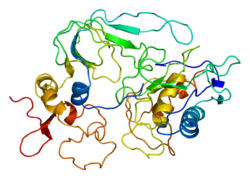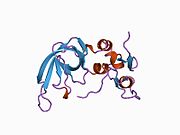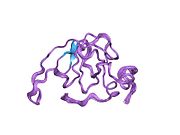Protein-coding gene in the species Homo sapiens
| TIMP2 |
|---|
 |
| Available structures |
|---|
| PDB | Ortholog search: PDBe RCSB |
|---|
| List of PDB id codes |
|---|
1BR9, 1GXD, 2TMP, 4ILW |
|
|
| Identifiers |
|---|
| Aliases | TIMP2, CSC-21K, DDC8, TIMP metallopeptidase inhibitor 2 |
|---|
| External IDs | OMIM: 188825; MGI: 98753; HomoloGene: 2444; GeneCards: TIMP2; OMA:TIMP2 - orthologs |
|---|
| Gene location (Human) |
|---|
 | | Chr. | Chromosome 17 (human)[1] |
|---|
| | Band | 17q25.3 | Start | 78,852,977 bp[1] |
|---|
| End | 78,925,387 bp[1] |
|---|
|
| Gene location (Mouse) |
|---|
 | | Chr. | Chromosome 11 (mouse)[2] |
|---|
| | Band | 11 E2|11 83.09 cM | Start | 118,191,895 bp[2] |
|---|
| End | 118,246,566 bp[2] |
|---|
|
| RNA expression pattern |
|---|
| Bgee | | Human | Mouse (ortholog) |
|---|
| Top expressed in | - tendon of biceps brachii
- synovial joint
- stromal cell of endometrium
- tibia
- urethra
- Descending thoracic aorta
- trigeminal ganglion
- ascending aorta
- right coronary artery
- visceral pleura
|
| | Top expressed in | - calvaria
- stroma of bone marrow
- ankle
- skin of external ear
- body of femur
- ventromedial nucleus
- subiculum
- anterior amygdaloid area
- endothelial cell of lymphatic vessel
- retinal pigment epithelium
|
| | More reference expression data |
|
|---|
| BioGPS |  | | More reference expression data |
|
|---|
|
| Gene ontology |
|---|
| Molecular function | - peptidase inhibitor activity
- enzyme inhibitor activity
- metal ion binding
- integrin binding
- protein binding
- protease binding
- metalloendopeptidase inhibitor activity
- zinc ion binding
| | Cellular component | - growth cone
- extracellular region
- cell surface
- neuronal cell body
- neuron projection
- extracellular exosome
- extracellular matrix
- extracellular space
- specific granule lumen
- tertiary granule lumen
- ficolin-1-rich granule lumen
- collagen-containing extracellular matrix
| | Biological process | - negative regulation of proteolysis
- response to cytokine
- negative regulation of peptidase activity
- positive regulation of adenylate cyclase activity
- human ageing
- extracellular matrix disassembly
- negative regulation of Ras protein signal transduction
- central nervous system development
- positive regulation of neuron differentiation
- response to hormone
- negative regulation of membrane protein ectodomain proteolysis
- positive regulation of MAPK cascade
- negative regulation of cell population proliferation
- negative regulation of mitotic cell cycle
- regulation of Rap protein signal transduction
- negative regulation of endopeptidase activity
- neutrophil degranulation
- negative regulation of metallopeptidase activity
- response to organic substance
| | Sources:Amigo / QuickGO |
|
|
| Wikidata |
| View/Edit Human | View/Edit Mouse |
|
Tissue inhibitor of metalloproteinases 2 (TIMP2) is a gene and a corresponding protein. The gene is a member of the TIMP gene family. The protein is thought to be a metastasis suppressor.[citation needed]
Function
The proteins encoded by this gene family are natural inhibitors of the matrix metalloproteinases (MMP), a group of peptidases involved in degradation of the extracellular matrix. In addition to an inhibitory role against metalloproteinases, the encoded protein has a unique role among TIMP family members in its ability to directly suppress the proliferation of endothelial cells. As a result, the encoded protein may be critical to the maintenance of tissue homeostasis by suppressing the proliferation of quiescent tissues in response to angiogenic factors, and by inhibiting protease activity in tissues undergoing remodelling of the extracellular matrix.[5] TIMP2 functions as both an MMP inhibitor and an activator. TIMPs inhibit active MMPs, but different TIMPs inhibit different MMPs better than others. For example, TIMP-1 inhibits MMP-7, MMP-9, MMP-1 and MMP-3 better than TIMP-2, and TIMP-2 inhibits MMP-2 more effectively than other TIMPs.[6]
In melanocytic cells TIMP2 gene expression may be regulated by MITF.[7]
A recent discovery is that TIMP2 plays an important role in hippocampal function and cognitive function. It plays a critical role in the benefit conferred to old mice when given human umbilical cord blood.[8][9] Its role in hippocampal function was later described to be related to its interactions with the extracellular matrix to regulate neurogenesis and dendritic spines plasticity.[10]
Interactions
TIMP2 has been shown to interact with:
See also
References
- ^ a b c GRCh38: Ensembl release 89: ENSG00000035862 – Ensembl, May 2017
- ^ a b c GRCm38: Ensembl release 89: ENSMUSG00000017466 – Ensembl, May 2017
- ^ "Human PubMed Reference:". National Center for Biotechnology Information, U.S. National Library of Medicine.
- ^ "Mouse PubMed Reference:". National Center for Biotechnology Information, U.S. National Library of Medicine.
- ^ "Entrez Gene: TIMP2 TIMP metallopeptidase inhibitor 2".
- ^ Bourboulia D, Stetler-Stevenson WG (June 2010). "Matrix metalloproteinases (MMPs) and tissue inhibitors of metalloproteinases (TIMPs): Positive and negative regulators in tumor cell adhesion". Seminars in Cancer Biology. 20 (3): 161–168. doi:10.1016/j.semcancer.2010.05.002. PMC 2941566. PMID 20470890.
- ^ Hoek KS, Schlegel NC, Eichhoff OM, Widmer DS, Praetorius C, Einarsson SO, et al. (December 2008). "Novel MITF targets identified using a two-step DNA microarray strategy". Pigment Cell & Melanoma Research. 21 (6): 665–676. doi:10.1111/j.1755-148X.2008.00505.x. PMID 19067971. S2CID 24698373.
- ^ Castellano JM, Mosher KI, Abbey RJ, McBride AA, James ML, Berdnik D, et al. (April 2017). "Human umbilical cord plasma proteins revitalize hippocampal function in aged mice". Nature. 544 (7651): 488–492. Bibcode:2017Natur.544..488C. doi:10.1038/nature22067. PMC 5586222. PMID 28424512.
- ^ "Blood from human babies makes brains of elderly mice young again". New Scientist. Apr 29, 2017.
- ^ Ferreira AC, Hemmer BM, Philippi SM, Grau-Perales AB, Rosenstadt JL, Liu H, et al. (September 2023). "Neuronal TIMP2 regulates hippocampus-dependent plasticity and extracellular matrix complexity". Molecular Psychiatry. 28 (9): 3943–3954. doi:10.1038/s41380-023-02296-5. PMC 10730400. PMID 37914840.
- ^ Zucker S, Drews M, Conner C, Foda HD, DeClerck YA, Langley KE, et al. (January 1998). "Tissue inhibitor of metalloproteinase-2 (TIMP-2) binds to the catalytic domain of the cell surface receptor, membrane type 1-matrix metalloproteinase 1 (MT1-MMP)". The Journal of Biological Chemistry. 273 (2): 1216–1222. doi:10.1074/jbc.273.2.1216. PMID 9422789.
- ^ Morgunova E, Tuuttila A, Bergmann U, Tryggvason K (May 2002). "Structural insight into the complex formation of latent matrix metalloproteinase 2 with tissue inhibitor of metalloproteinase 2". Proceedings of the National Academy of Sciences of the United States of America. 99 (11): 7414–7419. Bibcode:2002PNAS...99.7414M. doi:10.1073/pnas.102185399. PMC 124245. PMID 12032297.
- ^ Overall CM, Tam E, McQuibban GA, Morrison C, Wallon UM, Bigg HF, et al. (December 2000). "Domain interactions in the gelatinase A.TIMP-2.MT1-MMP activation complex. The ectodomain of the 44-kDa form of membrane type-1 matrix metalloproteinase does not modulate gelatinase A activation". The Journal of Biological Chemistry. 275 (50): 39497–39506. doi:10.1074/jbc.M005932200. PMID 10991943.
- ^ Bigg HF, Shi YE, Liu YE, Steffensen B, Overall CM (June 1997). "Specific, high affinity binding of tissue inhibitor of metalloproteinases-4 (TIMP-4) to the COOH-terminal hemopexin-like domain of human gelatinase A. TIMP-4 binds progelatinase A and the COOH-terminal domain in a similar manner to TIMP-2". The Journal of Biological Chemistry. 272 (24): 15496–15500. doi:10.1074/jbc.272.24.15496. PMID 9182583.
- ^ Kai HS, Butler GS, Morrison CJ, King AE, Pelman GR, Overall CM (December 2002). "Utilization of a novel recombinant myoglobin fusion protein expression system to characterize the tissue inhibitor of metalloproteinase (TIMP)-4 and TIMP-2 C-terminal domain and tails by mutagenesis. The importance of acidic residues in binding the MMP-2 hemopexin C-domain". The Journal of Biological Chemistry. 277 (50): 48696–48707. doi:10.1074/jbc.M209177200. PMID 12374789.
Further reading
- Liotta LA, Stetler-Stevenson W, Steeg PS (1991). "Metastasis suppressor genes". Important Advances in Oncology: 85–100. PMID 1869284.
- Stetler-Stevenson WG, Seo DW (March 2005). "TIMP-2: an endogenous inhibitor of angiogenesis". Trends in Molecular Medicine. 11 (3): 97–103. doi:10.1016/j.molmed.2005.01.007. PMID 15760767.
External links
- The MEROPS online database for peptidases and their inhibitors: I35.002
- Overview of all the structural information available in the PDB for UniProt: P16035 (Metalloproteinase inhibitor 2) at the PDBe-KB.
PDB gallery
-
1bqq: CRYSTAL STRUCTURE OF THE MT1-MMP--TIMP-2 COMPLEX -
1br9: HUMAN TISSUE INHIBITOR OF METALLOPROTEINASE-2 -
1buv: CRYSTAL STRUCTURE OF THE MT1-MMP-TIMP-2 COMPLEX -
1gxd: PROMMP-2/TIMP-2 COMPLEX -
2e2d: Flexibility and variability of TIMP binding: X-ray structure of the complex between collagenase-3/MMP-13 and TIMP-2 -
2tmp: N-TERMINAL DOMAIN OF TISSUE INHIBITOR OF METALLOPROTEINASE-2 (N-TIMP-2), NMR, 49 STRUCTURES |
 | This article on a gene on human chromosome 17 is a stub. You can help Wikipedia by expanding it. |

 1bqq: CRYSTAL STRUCTURE OF THE MT1-MMP--TIMP-2 COMPLEX
1bqq: CRYSTAL STRUCTURE OF THE MT1-MMP--TIMP-2 COMPLEX 1br9: HUMAN TISSUE INHIBITOR OF METALLOPROTEINASE-2
1br9: HUMAN TISSUE INHIBITOR OF METALLOPROTEINASE-2 1buv: CRYSTAL STRUCTURE OF THE MT1-MMP-TIMP-2 COMPLEX
1buv: CRYSTAL STRUCTURE OF THE MT1-MMP-TIMP-2 COMPLEX 1gxd: PROMMP-2/TIMP-2 COMPLEX
1gxd: PROMMP-2/TIMP-2 COMPLEX 2e2d: Flexibility and variability of TIMP binding: X-ray structure of the complex between collagenase-3/MMP-13 and TIMP-2
2e2d: Flexibility and variability of TIMP binding: X-ray structure of the complex between collagenase-3/MMP-13 and TIMP-2 2tmp: N-TERMINAL DOMAIN OF TISSUE INHIBITOR OF METALLOPROTEINASE-2 (N-TIMP-2), NMR, 49 STRUCTURES
2tmp: N-TERMINAL DOMAIN OF TISSUE INHIBITOR OF METALLOPROTEINASE-2 (N-TIMP-2), NMR, 49 STRUCTURES
























